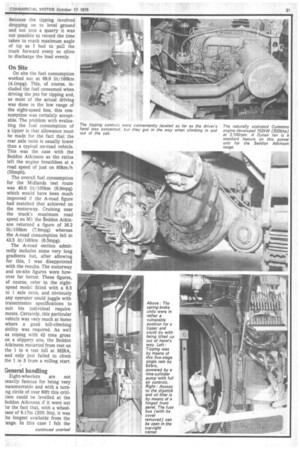Seddon Atkinson R30 C220 8 x 4 tipper
Page 32

Page 33

If you've noticed an error in this article please click here to report it so we can fix it.
THE eight-wheeler from the new Seddon Atkinson series owes a lot to the old Atkinson version, which has been given a new lease of life with the specification of the new tilt cab. The version I have just tested was fitted with a naturally aspirated Cummins engine developing 152kW (204 bhp) coupled to an eight-speed David Brown gearbox. In general, the truck showed up very well although the fuel consumption was only average and a couple of points about the design were not very suitable for tipper operation.
Mechanical details
The power unit was the naturally aspirated Cummins NH 220 of 743cuin (12.2 litres) cubic capacity, which produced its maximum power of 152kW (204bhp) at 2,100rpm. Because of the need to install an extra joint in the gear linkage to allow for the tilting of the cab, the gearchange pattern of the David Brown gearbox has had to be reversed so that first gear is towards the driver and back, with the remaining gears following in anti-clockwise progression (the same arrangement as on the 400 series tractive unit with the Fuller gearbox tested by CM in April). An Eaton double-drive rear bogie with differential lock was specified and in deference to the requirements of on/off-road operation a rear axle ratio of 6.5 to 1 was fitted.
The Edbro built body was of all-welded alloy construction with a five-stage single ram.
The eight-wheeler spent a day on site by courtesy of the St Albans Sand and Gravel Co Ltd, followed by the performance testing at the MIRA proving ground. To check the fuel consumption on the road I took the truck around our 312km (194 miles) Midlands test route.
Performance
The on-site arrangement was for the truck to collect a load of sand from one site and transfer it to the processing plant about a mile down the road.
The truck was required to negotiate a slope on the site of approximately 1 in 9 in the fully laden condition. Early in the day while juggling arouri with scoops to estimate the legal pay load which the Seddon Atkinson could carry the truck was laden to ovei 42 tons gross. As the weigh bridge was at the other side of the site I had to drive thE truck across in this state be fore I had any idea what the load weighed.
This situation arose mainl] because the large Edbro bod! completely dwarfed the load o wet sand and even at 42 ton gross the body was only hal full.
At this weight the trucl coped well and climbed till short gradient to the tippir4 site with no difficulty, althoug I was careful to find a very fia piece of ground to park th vehicle before tipping.
I felt that the tipping con trols were badly situated a they got in the way when en tering and leaving the cab an( on this particular type of opei ation, where the driver has t get in and out frequently, thi would be a serious nuisance Because the tipping involved dropping on to level ground and not into a quarry it was not possible to record the time taken to reach maximum angle of tip as I had to pull the truck forward every so often to discharge the load evenly.
On Site
On site the fuel consumption worked out at 68.9 lit/100km (4.1mpg). This, of course, included the fuel consumed when driving the pto for tipping and, as most of the actual driving was done in the low range of the eight-speed box, this consumption was certainly acceptable. The problem with evaluating the fuel consumption of a tipper is that allowance must be made for the fact that the rear axle ratio is usually lower than a typical on-road vehicle. This was the case with the Seddon Atkinson as the ratios left the engine breathless at a road speed of just on 80km/h (56mph).
The overall fuel consumption for the Midlands test route was 40.9 lit/100km (6.9mpg) which would have been much improved if the A-road figure had matched that achieved on the motorway. Cruising near the truck's maximum road speed on M1 the Seddon Atkinson returned a figure of 36.2 lit/100km (7.8mpg) whereas the A-road consumption fell to 43.5 lit/100km (6.5mpg).
The A-road section admittedly includes some very long gradients but, after allowing for this, I was disappointed with the results. The motorway and on-site figures were however far better. These figures, of course, refer to the eightspeed model fitted with a 6.5 to 1 axle ratio, and obviously any operator could juggle with transmission specifications to suit his individual requirements. Certainly, this particular vehicle was very much at home where a good hill-climbing ability was required. As well as coping with 42 tons gross on a slippery site, the Seddon Atkinson restarted from rest on the 1 in 4 test hill at MIRA, and only just failed to climb the I in 3 from a rolling start.
General handling
Eight-wheelers are not ?xactly famous for being very manoeuvrable and with a turn.ng circle of over 80ft this criti:ism could be levelled at the 3eddon Atkinson if it were not or the fact that, with a wheel)ase of 6.17m (20ft 3in), it was be longest available from the .ange. In this case I felt the
































































































